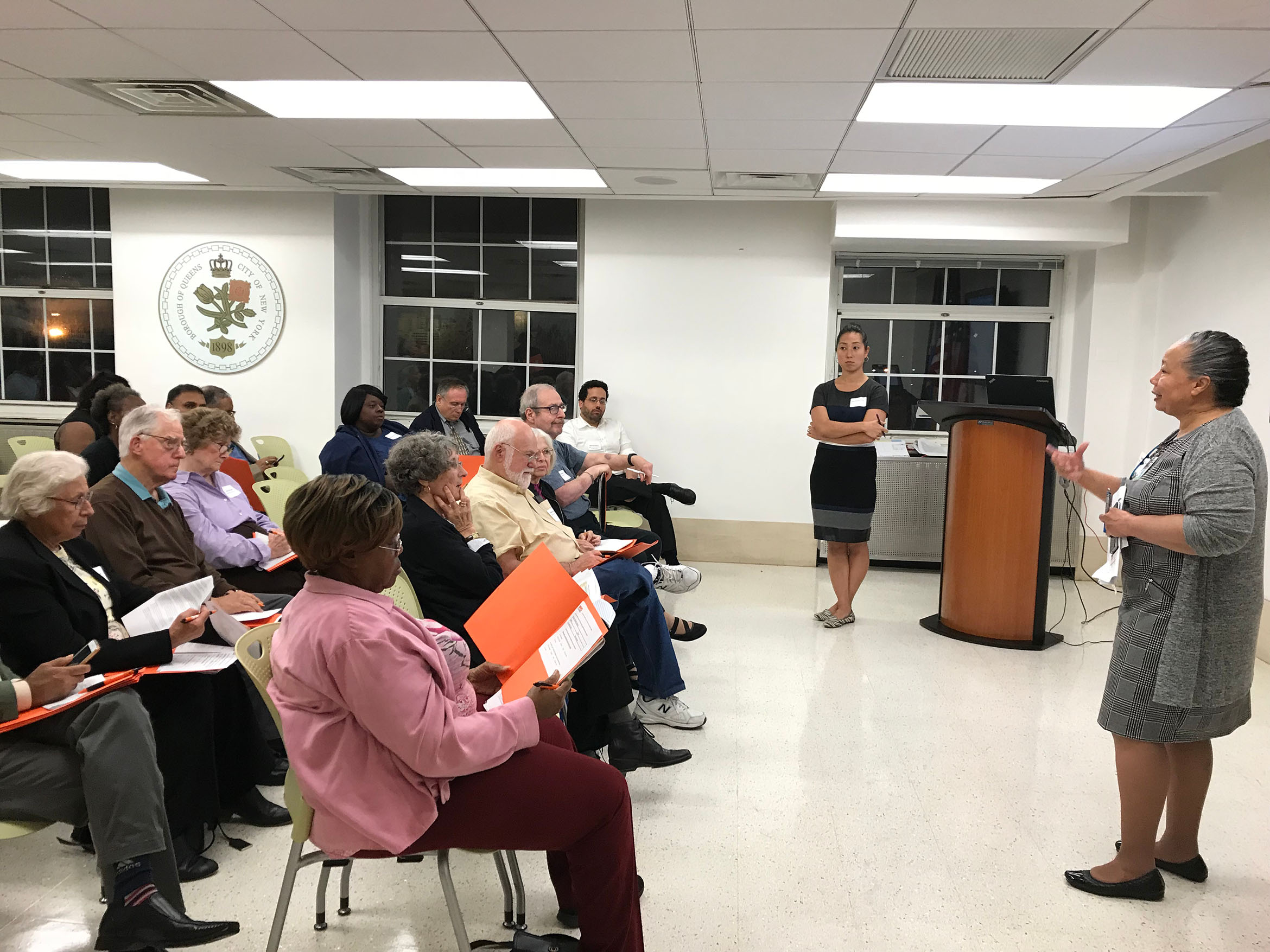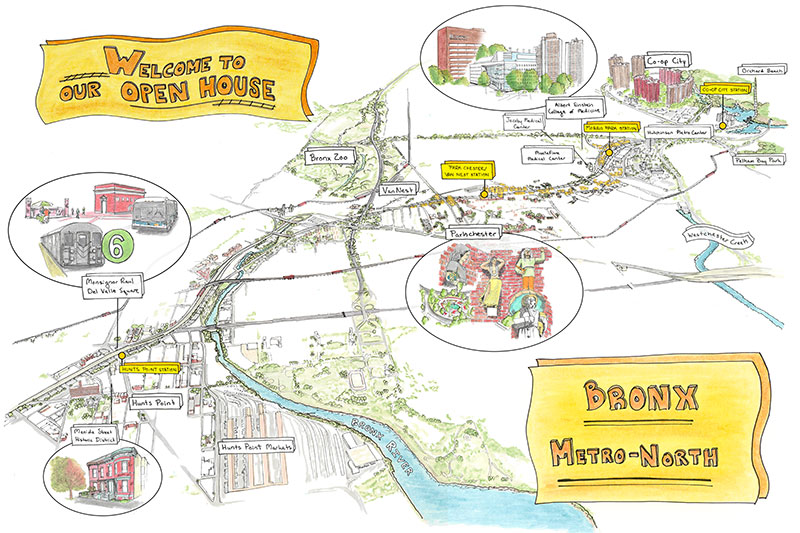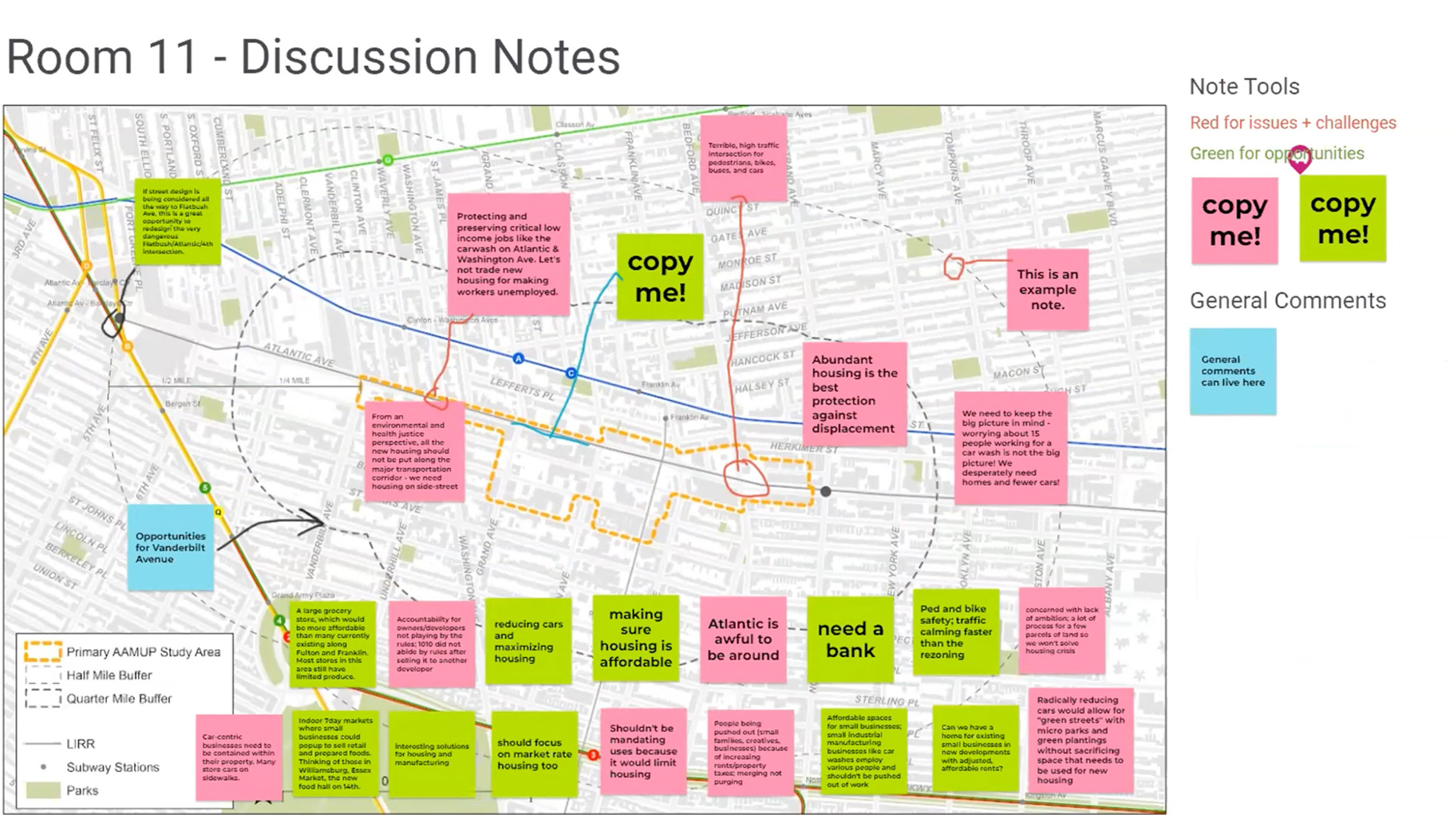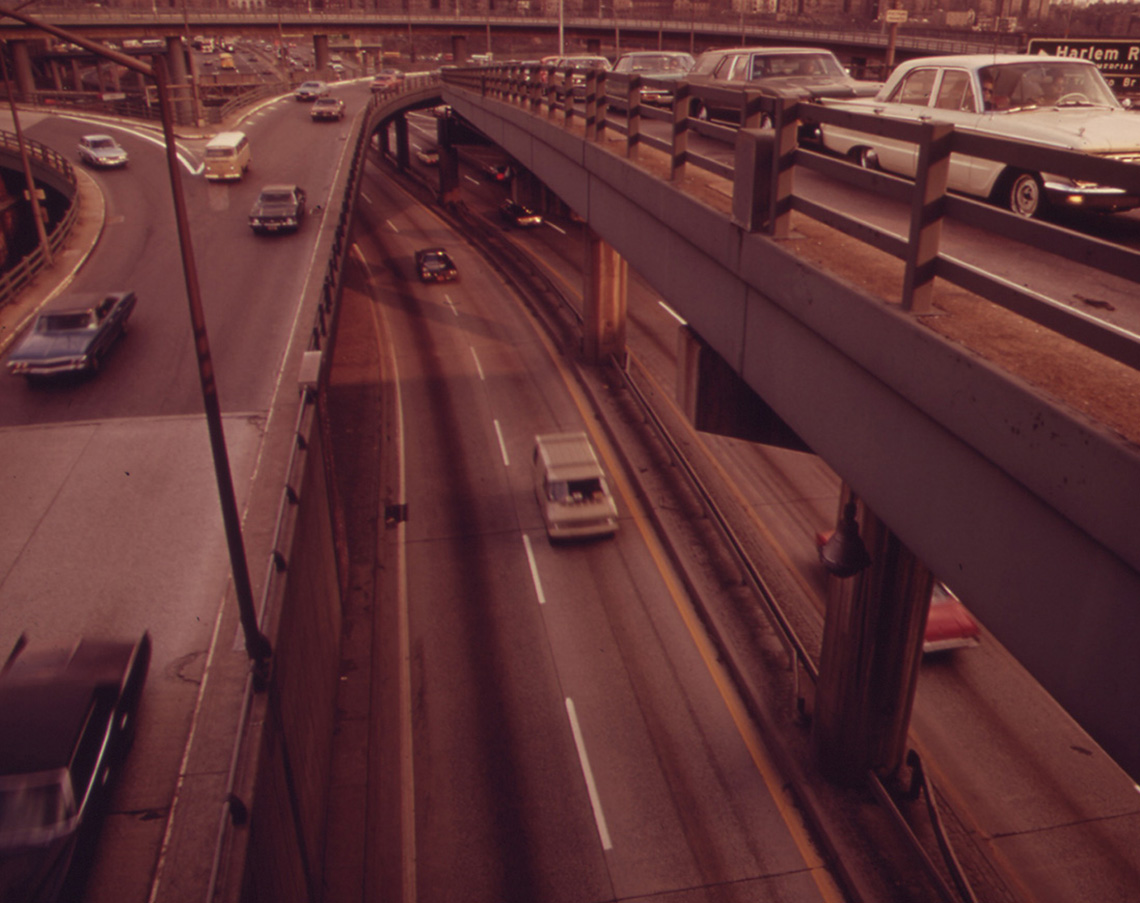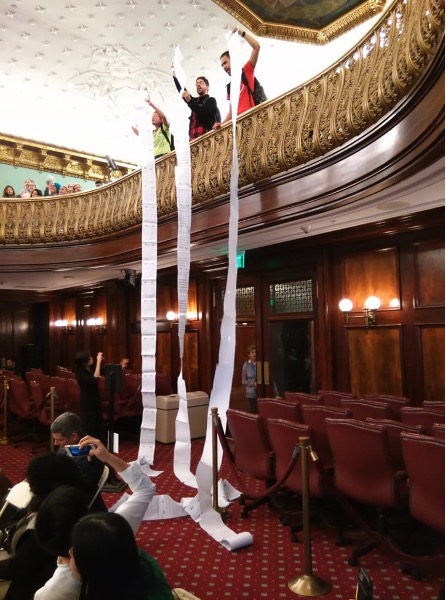
We are celebrating 15 years — and counting — of stories that are deeply researched and deeply felt, that build a historical record of what the city has been.
We are celebrating 15 years — and counting — of stories that are deeply researched and deeply felt, that build a historical record of what the city has been.
The route to meet with members of the new Community Planning and Engagement division at New York City’s Department of City Planning (DCP) offers a neat lesson in the fraught relationship of planners to their publics. The subway opens into the Oculus, a symbol of a city whose form is dictated by the vanities of the powerful, not the needs of the people. From there, it’s a few blocks to the Equitable Building — whose sun-squashing bulk was one motivator for the city’s first zoning laws, constraining private construction to collectively safeguard light and air. Then, up to DCP’s HQ on the 31st floor and a conference room offering the proverbial view from above, whence planners, in their zest to apply their expertise to the city below, cannot see their impacts on the little people who call it home.
Over the last half century, policymakers’ disregard for the experiences of ordinary citizens have been tempered by participatory processes to make land use decisions more democratic. And yet… The urgent need to decarbonize, adapt to a changing climate, and create a lot more housing, and — at the same time — the weaponization of public processes by the well-off to preserve their narrow interests have many policymakers and pundits suggesting that “community input is bad, actually.” Into the fray steps City Planning’s new community engagement team and its Civic Engagement Studio, with a mandate to level up participatory processes for the agency as a whole, and to bring creativity where there is a lot of room for improvement. We spoke to Lara Mérida, Elizabeth Hamby, and Jasmin Tepale about new ways to reach communities, build trust, and stay accountable to New Yorkers’ needs and desires in the context of historic injustice and an uncertain future.
Why a designated unit for community engagement for all of the Department of City Planning? And why now?
One of the things that we love about being planners is working with communities and making sure that we’re engaging in ways that foster partnerships, community conversations, and good policy. Before the pandemic, we started talking about transforming the way that we’re engaging. COVID expedited us into finding new ways for people to be part of meetings and joint conversations. We recognized that there’s an opportunity to transform how DCP organizes itself to be able to work with communities better and more often. We created the Civic Engagement Studio as a dedicated space for planners to come together to think about the future of how people want to engage. And we created this department that’s focused on making sure New Yorkers’ voices are being heard in the policies that are being developed, and setting up spaces for people to have conversations.
For the last eight to ten years, there’s been a watershed around how the City of New York plans for housing growth and large-scale catalytic projects, moving to creating community plans upfront — before the official deliberative processes of ULURP and environmental review kick off — as a place where communities, elected officials, and other neighborhood stakeholders can all work with agencies. Not just about zoning, but about neighborhood services, capital investments, other ideas and priorities. We did a lot of very fast learning. Now, we have a chance to institutionalize the practice. And we’re making this investment in the team, so that as an agency we have the tools, the processes, the space to dream, in order for that to be successful.
I worked in the borough offices before I joined this team, mainly focused in Manhattan. Weighing the community board’s voices versus voices of local organizations, there were a lot of competing interests. A lot of what we deal with are those competing interests, trying to find the best way to make sure the voices who are underrepresented do get a platform there. It’s just too easy to push certain people to the side. I know that’s why I wanted to join the division, but I also think that as an agency, the feeling was: “We need to prioritize this, we can’t wait any longer on this.”
On the subject of competing interests and especially who doesn’t get heard among the loudest voices: Part of the brief for the Civic Engagement Studio, as it’s been presented, is finding other ways of doing engagement. I’m usually skeptical of the term, but there’s a lot of room for innovation there. The Studio’s first project was actually a high school curriculum. Why start there, and what have you learned so far?
When we started the Studio program, we took an opportunity to ask, “Whose voice isn’t at the table? And who is not hearing each other?” We don’t see youth in our meetings, at our community boards. We thought it was important that they knew that they had a voice. We didn’t particularly know that it would become a curriculum. We started reaching out to multiple high schools and asking, “Hey, anybody want to partner with us and get youth involved?” And we heard some coming back with, “We could do an after-school event,” or, “Come to our show-and-tell-day.” The Laboratory School of Finance and Technology in the Bronx said to us, “We’re very intrigued by this, and we’d like to build an actual curriculum with you.” We couldn’t pass that opportunity up.
When we first walked in, the students thought we would just be giving a lecture, and then there’s a quiz or something. And we were like, “No, no, no. What happens in advocacy, what happens in building community and trust is we gotta hear from you.” I’m excited about what came out of that. The students had an opportunity to not only learn about planning and civic activity, but they were able to build their own projects focused on affordable housing, sustainability, and transportation, and then we had a big event with commissioners and deputy mayors attending, and they pitched their ideas to them.
What’s exciting is that we now have this incredible body of content. We have a list of civics topics that are specific to how New York City works. That’s valuable information for young people, and also valuable information for most adults. But we also have a protocol for how this agency, which doesn’t typically work with schools or with young people, can do that work. That opens up all kinds of doors for how we could do other programs in the future.
Another thing that we’ve been thinking about as a division, and as part of the Studio, is making sure that there’s a foundation and structure there that doesn’t die with one of us. Anybody else can pick it up and actually make something of it. We’ve been thinking of that as our tools library, so we have a home for these things to live in, and we’re going to continuously update it. Our dream is to expand it out for other city agencies and organizations to use.
I see the Studio as almost the engine of innovation for the whole agency. It’s the place where folks are having deep conversations about what’s needed and how we work together better. Recently, we pulled together the Studio for a full day retreat to talk about where we’ve been, and where we should go next. The range of ideas discussed was an incredible portrait of the challenges and opportunities we have from a civic engagement perspective as a city. It included everything from “How do we advance language justice in our work?” to “How do we make sure that the tech tools that we develop are things that people can actually use?” or, “How do we constantly build our skills and practices as facilitators, so that we can run better meetings?” The folks in that room are the people in this agency who care so deeply about engagement practice. In so many ways, they are the heart of what we’re doing.
The feeling right now is that our pro-forma mechanisms for participation, the public meeting and hearing, may be irreparably broken. Many people want to scrap community consultation altogether, arguing that it’s obstructionist, and we need to get stuff done. So where do you go from there? How do you navigate that and find ways to do engagement differently, or more meaningfully, going forward?
I don’t think there’s a world where we get rid of the traditional ways that we do engagement. We are a city that has a good system of community boards. There are places of convening, and a public review process that is incredible for the city. I’ve worked in other cities that don’t lay out so clearly when communities can participate. It is something we need to cherish, and continue, and help it grow, and get more people to participate, if that’s what they want. But we have a lot of conversations about how much time we are taking out of people’s busy day-to-day lives. We think it is important to make sure that the person who wants to participate online can do that. The person who wants to dedicate 15 minutes a week, they have a way of doing that. The person who wants to come to a gymnasium and dedicate two hours has an opportunity to do that.
So many times in New York City history, in the history of the United States, whenever public goods start to become available to people who are poor, to people who are not white, we start screaming about the failure of those public goods, whether it’s public transportation or public housing. Now, it’s public meetings. Just like we’ve seen with those kinds of public infrastructure, our civic infrastructure has been disinvested in. We have not put resources into supporting this vital part of our democracy. To use that as an excuse to take even more resources away is not a good faith argument. We’re coming from the position that more investment, more creative ways for people to participate, is the path forward. It’s about power, at the end of the day.
One of the difficulties we face is balancing citywide interests with more immediate neighborhood ones. When it comes to building housing, or climate adaptation, a neighborhood has a place, it’s got a constituency, it’s got organizations. But local projects have implications for the whole city. How are you approaching initiatives for housing and densification right now? You are working on the citywide proposals for the “City of Yes” on the one hand, and big rezoning studies in the Bronx and Brooklyn on the other.
We are working on citywide perspectives on larger things like our climate crisis, our housing crisis, and the economic emergency that we’re in. That’s what the City of Yes is focused on. When we’re thinking about engagement, we’re thinking about collaborating with communities at the neighborhood level, and at the citywide level. This is on all fronts.
It’s tough to think about engagement citywide, for an initiative that covers every corner, every block. Right now, we’re focusing on an initiative that is going to help the city move towards more of our climate goals, but in the sense that zoning is one piece of a larger city effort. We’ve been trying to create a process which is intentionally, comprehensively thinking about who’s affected by these citywide proposals: who benefits from these changes, and who doesn’t benefit from these changes.
It’s a question that we just keep coming back to, because it’s important to not lose perspective that even though these crises affect everybody, they affect everyone differently. Lara always does a great job of reminding us, “How does this affect the city? How does this affect my neighborhood? How does it affect me individually?” Internally, that’s been such a big change with our projects, and now our team is solely focused on those questions.
There’s this major transportation investment coming to the Bronx, with the opening of four new Metro North stations, that will be transformative for people who live along that line, in terms of access to employment, to the rest of the city, to the region. It’s catalytic in every way. But it’s also really different. As we plan with communities for how and where they should grow new housing and jobs around the new stations, the Bronx planning office found creative ways to make themselves available to answer people’s questions. They set up open office hours, where anybody from the community can book a 15-minute sit down with a planner and ask a question, or talk about their ideas, or gain clarification into what’s going on. While these are such big ideas and big changes, those very small interactions are vital to make sure that those are changes for everybody.
At Atlantic Avenue, where we’re looking to support new housing with affordable housing, new space for jobs and services, infrastructure investments, and more, the community board came to us and said, “We want to hear more about planning and what we can do here.” We worked really closely with them for a few years.
In that case, you have an elected official who is saying, “Okay, my neighbors came up with this idea. I’m going to take this leading role in bringing that to reality.” City Council member Crystal Hudson, who represents the district where the Atlantic Avenue mixed use project is taking place, has taken a leading role in gathering her neighbors to talk about what this plan should be and how it should work. We’re there to partner with her. We’re also working with WXY as a consultant on this process. She’s supported by a great team who can help set up the conversations, make sure that we’re asking the right questions.
There is enormous work to be done in building more housing, equitably. At the same time, we are perhaps moving toward dismantling some of the more nefarious projects of the twentieth century. You’ve also just launched the engagement process for determining the future of the Cross Bronx Expressway. One can make an argument for its economic benefits to the city as a whole, but the outcomes for residents of the Bronx, from the original destruction of neighborhoods to the present-day health impacts, have been enormously damaging. What does it look like to work with communities to start to think about how that gets addressed, whatever the ultimate result is?
With the Cross Bronx, we’re just going out to meet with the public for the first time. There’s a community working group who is working hand-in-glove with the agency team: City Planning, New York City and New York State Departments of Transportation, and the City Department of Health. They’re meeting regularly to say, “This is how we should do this engagement. These are the types of questions we should ask. These are the types of forums we should be in. This is how this should operate.” There’s also a technical advisory group; that’s a place where public health practitioners, academics, researchers, advocates, can come and say, “Here’s how we should evaluate these proposals. Here’s how we should think about this from a technical perspective.” There will be public forums and community-led events, where we are going out to folks to say, “Here’s the opportunity. What are your hopes, dreams, concerns, and aspirations?” But also spaces that they can create for themselves to tell us what that conversation should look like. The Cross Bronx is a highway, but it’s also this symbol. We have to work in a way that’s practical and concretely improving people’s lives, but also is speaking to their hearts, and their memories, their history, and the aspirations of what they want to be in the future.
I want to ask you about the notion of trust: how people trust there are fair processes in place, that those are meaningful, and who is a trusted messenger in a given community. In many circumstances, that trust might not be there, based on being burned in the past. So many communities have either experienced non-consultation, or — the story of East River Park is just one recent and well-publicized example — gone through extensive community engagement only to see a plan ultimately, unilaterally scuttled. There are multiple questions here about the kinds of partnerships and modes of engagement that allow or seek to develop trust on the part of residents and the city.
Trust is a complex word. I don’t see it as either you have trust or you don’t have trust; it’s more like a spectrum. There’s a whole school of thought where you can never gain that trust back, and maybe the idea isn’t to gain communities’ trust but to really make sure you’re working with them regardless if you can gain their trust or not, because you may never get their trust back. But the other side of the spectrum is that we should always be striving to gain folks’ trust.
One thing that we’re doing for the City of Yes is to help build that bridge a little more by coming to communities earlier in the process. Instead of waiting until the formal process of ULURP when we’re supposed to be doing these things, when we kicked off City of Yes, we started asking, “Here’s what we’re thinking. How does this look to everybody?” As we got further along in the project, we kept giving more information. Recently, we did an info session on City of Yes for Carbon Neutrality that had many technical details most people probably didn’t even want to know. We wanted to make sure that information is out there. I help support the planners who go to community board meetings, so I know a lot of community boards have told us, “We actually really appreciated you coming to us a lot earlier in the process.” That was a small gesture, to be like, “We mean what we say. If you want to hear from us, we’re here, and we’d be more than happy to come out and speak to everybody.” I know we say that, but we actually show it through our actions, and I hope that’s coming through.
We want to make sure that we’re accessible and transparent. We are public servants, and we are here to listen and to see how we can shape policy better.
In addition to transparency and accountability, we’re working to be more predictable about how and when we show up. This has been a learning process over the last ten years; a lot of our thinking now is about getting to a playbook. Understanding that there is no cookie cutter approach, what are the things that we can put in place so that people know when to expect us, and what to expect from us, and then consistently deliver that?
And what should people expect from that engagement? There’s a question of information flow, which is about making sure that the public is informed — actually, actionably informed — and soliciting information that should make better plans. But then there’s a larger accountability question. Is engagement about inform and consent, or, as people are gathering and bringing their hopes, and dreams, and aspirations, does that show up as a meaningful form of participation in planning?
A plan is not the universe, right? A plan is a tool that is used to guide a set of policy decisions and investments to support a neighborhood. In addition to making really good plans that have technically informed and community informed recommendations, we are working to leave behind relationships and people who can work together — with each other and with us — through the implementation of the specific recommendations that are laid out in a plan and beyond.
So much of how we’ve been talking about our work lately is this “community boards-and” strategy. Understanding that community boards are the official civic infrastructure that is responsible for guiding land use and planning decisions, we want to make sure that they have everything that they need to be strong and successful. Then, there are all of these other entities that, for a whole host of reasons, are not connected to that infrastructure. So what can we do to build awareness, and relationships, and systems of working together, whether those are community working groups, or committees, or steering groups, or walking groups? Whatever it is, groups of people who can deliberate with each other, can deliberate with us, and move forward collective ideas. That’s what we strive for.
What are your goals and aspirations for your first year? What does success look like for you?
This first year, it’s really thinking about how we organize ourselves internally, laying out the principles that we believe in, and values that we hear from communities on what the expectation of engagement is. How do we incorporate that and make sure that it’s at the forefront of the work that we’re doing? Seeing progress happen in these really critical conversations that we’re having right now about climate, housing, and our economic state is really important to us this year. And making sure we’re getting resources from across city agencies to our communities.
I’m hoping that we can actually start working through how we define what success looks like. Nationally, every planning agency is grappling with, “What are the right metrics?” Because the right metrics aren’t that we held a meeting and X number of people showed up. What does true, good, big, strong, engagement mean? Usually, we can feel it. It’s something that you feel when you’re in the room. But there are really good questions, like Jasmin brought up, about who’s benefiting from this work. What was the impact? And how are we getting to a better place?
A lot of it is building the foundation. Engagement never ends or stops. But whether it’s this first year, or next year, how do we institutionalize a lot of the stuff that we’re doing now? That way, we all have a baseline to know our planners are thinking about equity in our work. We can have better conversations when we go out to speak with people, not just us holding a meeting and whoever comes comes. That’s not how you measure great engagement. In a city that speaks hundreds of languages, there are so many underrepresented voices.
The views expressed here are those of the authors only and do not reflect the position of The Architectural League of New York.
